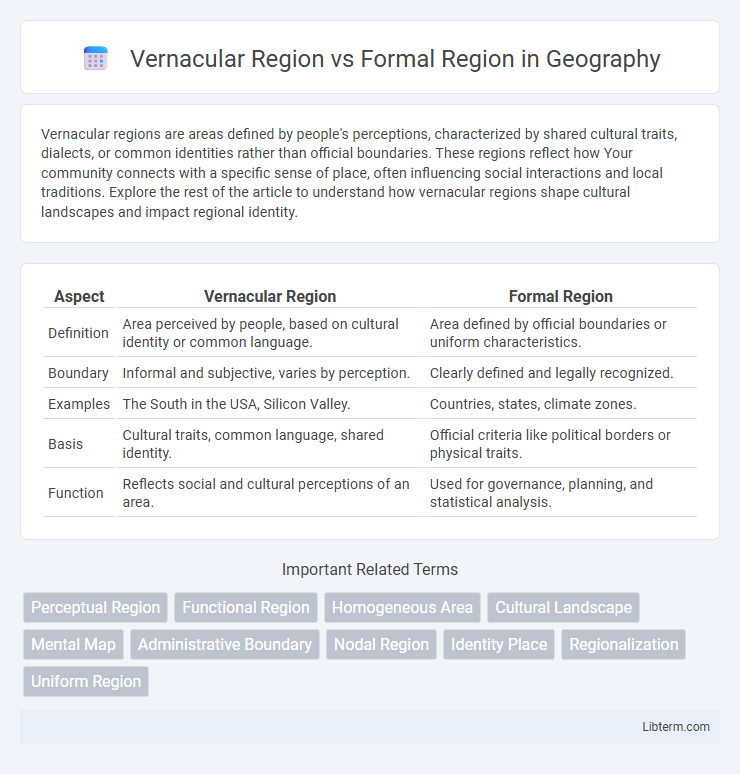Vernacular regions are areas defined by people's perceptions, characterized by shared cultural traits, dialects, or common identities rather than official boundaries. These regions reflect how Your community connects with a specific sense of place, often influencing social interactions and local traditions. Explore the rest of the article to understand how vernacular regions shape cultural landscapes and impact regional identity.
Table of Comparison
| Aspect | Vernacular Region | Formal Region |
|---|---|---|
| Definition | Area perceived by people, based on cultural identity or common language. | Area defined by official boundaries or uniform characteristics. |
| Boundary | Informal and subjective, varies by perception. | Clearly defined and legally recognized. |
| Examples | The South in the USA, Silicon Valley. | Countries, states, climate zones. |
| Basis | Cultural traits, common language, shared identity. | Official criteria like political borders or physical traits. |
| Function | Reflects social and cultural perceptions of an area. | Used for governance, planning, and statistical analysis. |
Understanding Vernacular and Formal Regions
Vernacular regions are defined by people's perceptions, often based on cultural identity, language, or shared history, which leads to subjective boundaries like the American South or the Bible Belt. Formal regions consist of clearly defined administrative or governmental boundaries characterized by uniform features such as climate, language, or political governance, exemplified by states, countries, or census regions. Understanding these distinctions highlights how vernacular regions reflect social constructs and cultural affiliations, whereas formal regions emphasize objective criteria and official delineations.
Defining Vernacular Regions
Vernacular regions are defined by people's perceptions, cultural identity, and shared experiences rather than strict boundaries or official designations. These regions often emerge from local language, customs, and collective understanding, such as "The Midwest" or "The South" in the United States. Unlike formal regions with precise geographic borders, vernacular regions remain fluid and subjective, reflecting social constructs rather than administrative lines.
Characteristics of Formal Regions
Formal regions are defined by homogeneous characteristics such as uniform language, climate, or economic activity, making their boundaries clearly identifiable and consistent. These regions exhibit measurable data patterns like political boundaries or administrative divisions, ensuring uniformity in governance or regulation. The definitive nature of formal regions supports effective planning and resource allocation within their established borders.
Key Differences Between Vernacular and Formal Regions
Vernacular regions are defined by people's perceptions and cultural identity, lacking precise boundaries, while formal regions rely on clearly defined borders based on governmental or physical criteria. Formal regions often have homogeneous characteristics such as language, climate, or political boundaries, whereas vernacular regions reflect subjective social or cultural constructs like "the South" or "the Midwest." This distinction highlights that formal regions emphasize uniformity and measurable factors, whereas vernacular regions emphasize local identity and collective human experience.
Examples of Vernacular Regions
Vernacular regions are areas defined by people's perceptions, often based on cultural identity or shared characteristics, such as the American South, known for its distinct dialects, cuisine, and traditions. Another example is Silicon Valley, identified by its concentration of technology companies and innovation culture rather than official boundaries. These regions contrast with formal regions, which have clearly defined borders and official recognition, like the state of California or the Sahara Desert.
Examples of Formal Regions
Formal regions are defined by officially recognized boundaries and uniform characteristics such as climate, language, or political jurisdiction. Examples include the state of California with its specific legal and administrative borders, the Sahara Desert characterized by its arid climate, and the French-speaking province of Quebec in Canada defined by linguistic criteria. These regions are contrasted with vernacular regions, which are based on people's perceptions and cultural identity rather than precise boundaries.
Uses of Vernacular Regions in Geography
Vernacular regions in geography serve as key tools for understanding cultural identity and regional perception by local populations, reflecting shared language, customs, and historical experiences. These regions help geographers analyze social dynamics, regional stereotypes, and spatial behavior without relying on officially defined boundaries. Insights gained from vernacular regions assist in urban planning, marketing strategies, and cultural preservation efforts by highlighting the subjective and lived experiences of place.
Uses of Formal Regions in Geography
Formal regions in geography are defined by uniform physical or human characteristics, such as climate zones or political boundaries, enabling precise spatial analysis and data collection. These regions facilitate resource management, urban planning, and policy implementation by providing clear, measurable criteria for decision-making. Geographic information systems (GIS) frequently utilize formal regions to map and analyze demographic trends, environmental conditions, and economic activities.
Importance of Regional Classification
Regional classification plays a crucial role in geographical analysis by distinguishing between vernacular and formal regions, enabling better understanding of cultural identity and administrative boundaries. Vernacular regions reflect perceptual and cultural distinctions based on people's shared perceptions, which influence social cohesion and local customs. Formal regions are defined by official, measurable criteria such as political borders or climate zones, facilitating governance, policy implementation, and resource management.
Vernacular vs Formal Regions: Implications for Cultural Identity
Vernacular regions are defined by people's perceptions and cultural identity, reflecting shared language, traditions, and social norms that create a sense of belonging and place attachment. Formal regions, identified by official boundaries and uniform characteristics such as climate or political governance, offer clear administrative frameworks but may overlook the nuanced cultural identities within them. Understanding these distinctions helps in recognizing how cultural identity is shaped more strongly by vernacular regions than by legally defined formal regions.
Vernacular Region Infographic

 libterm.com
libterm.com